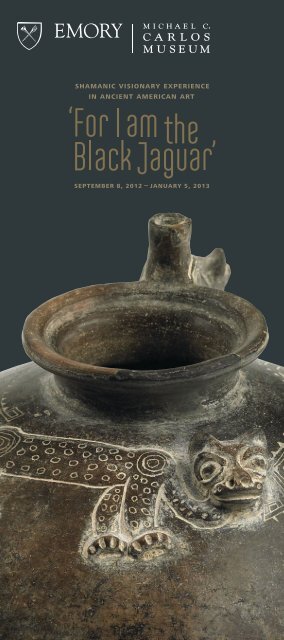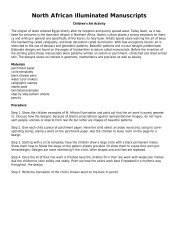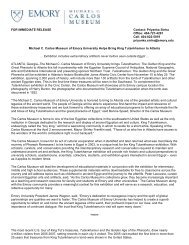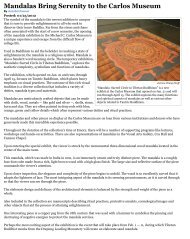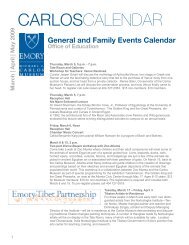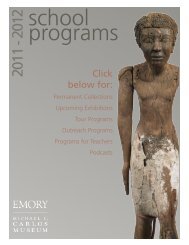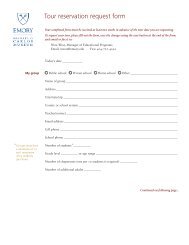For I am the Black Jaguar - Michael C. Carlos Museum - Emory ...
For I am the Black Jaguar - Michael C. Carlos Museum - Emory ...
For I am the Black Jaguar - Michael C. Carlos Museum - Emory ...
You also want an ePaper? Increase the reach of your titles
YUMPU automatically turns print PDFs into web optimized ePapers that Google loves.
From earliest times to today, indigenous peoples of <strong>the</strong> Americas<br />
have valued sh<strong>am</strong>anic visionary trance as one of <strong>the</strong>ir most<br />
important cultural and religious experiences. In Meso<strong>am</strong>erica,<br />
Central America, and <strong>the</strong> Andes sh<strong>am</strong>ans still speak of <strong>the</strong>ir wondrous<br />
trance journeys to o<strong>the</strong>r cosmic realms, <strong>the</strong> truths <strong>the</strong>y learn, and <strong>the</strong><br />
information <strong>the</strong>y bring back to cure <strong>the</strong>ir communities’ ills.<br />
The exhibition ‘<strong>For</strong> I <strong>am</strong> <strong>the</strong> <strong>Black</strong> <strong>Jaguar</strong>’: Sh<strong>am</strong>anic Visionary<br />
Experience in Ancient American Art, on view from September 8, 2012,<br />
through January 5, 2013, highlights works from <strong>the</strong> <strong>Carlos</strong> <strong>Museum</strong><br />
collections that embody <strong>the</strong> sh<strong>am</strong>anistic visionary experience. The<br />
show’s title is based on a quote from a contemporary traditional<br />
Taulipang sh<strong>am</strong>an of nor<strong>the</strong>rn Brazil, “Call upon me for I <strong>am</strong> <strong>the</strong><br />
black jaguar…I drive away <strong>the</strong> illness…”<br />
The sh<strong>am</strong>an’s statement conveys <strong>the</strong> most pervasive sh<strong>am</strong>anic<br />
visionary experience of actually becoming a powerful animal, <strong>the</strong><br />
black jaguar in particular.<br />
The exhibition includes extraordinary works of art showcasing <strong>the</strong><br />
most important elements of trance consciousness, especially <strong>the</strong><br />
visionary himself or herself, transforming into an animal such as a<br />
powerful black jaguar, an enormous whale shark, a predatory owl,<br />
or a venomous rattlesnake. Animal selves and spirit companions are<br />
considered to be guides to <strong>the</strong> sh<strong>am</strong>an in caring for <strong>the</strong> community,<br />
<strong>the</strong> animals’ powers augmenting <strong>the</strong> sh<strong>am</strong>an’s innate healing abilities.<br />
Works of art illustrate how visions are achieved in traditional<br />
settings—from meditation, to drumming and dancing, to ingesting<br />
sacred plants such as peyote, caapi vines, and espingo seeds.<br />
Modern sh<strong>am</strong>ans refer to <strong>the</strong>se as “plant teachers,” and <strong>the</strong>y are<br />
understood to be wise spiritual guides through <strong>the</strong> cosmic realms<br />
beyond <strong>the</strong> terrestrial.<br />
The exhibition ex<strong>am</strong>ines <strong>the</strong> central role that visionary experience plays<br />
in Amerindian sh<strong>am</strong>anism—informing art in all media, periods and<br />
regions—and demonstrates how contemporary accounts by<br />
practicing sh<strong>am</strong>ans can illuminate <strong>the</strong> choices made by ancient<br />
American artists.
EDUCATIONAL PROGRAMS<br />
Thursday, September 13 *<br />
7:30 pm, Level Three Galleries<br />
Gallery Talk<br />
Dr. Rebecca Stone, Masse-Martin/neh Distinguished Professor of Art<br />
History at <strong>Emory</strong> University and curator of ‘<strong>For</strong> I <strong>am</strong> <strong>the</strong> <strong>Black</strong> <strong>Jaguar</strong>,’<br />
leads visitors through <strong>the</strong> exhibition highlighting major <strong>the</strong>mes and objects.<br />
Saturday, September 15<br />
10 <strong>am</strong>, Level Three Galleries<br />
Artful Stories<br />
As long as <strong>the</strong>re have been people on <strong>the</strong> earth <strong>the</strong>y have looked at <strong>the</strong><br />
night sky and told imaginative stories about <strong>the</strong> celestial bodies <strong>the</strong>y could<br />
see. Hear a story about jaguars and <strong>the</strong> moon from <strong>the</strong> Toba people of<br />
Bolivia while surrounded by images of jaguars in <strong>the</strong> exhibition. Afterwards,<br />
enjoy an exploration of <strong>the</strong> skies of <strong>the</strong> ancient Americas in <strong>the</strong> StarLab<br />
portable planetarium from Fernbank Science Center. <strong>For</strong> ages 3 to 5 years<br />
and accompanying adults. These progr<strong>am</strong>s are free but a reservation is<br />
required by calling 404-727-0519.<br />
Sundays, September 16 & 30<br />
2 pm, Tate Room<br />
Children’s Workshop<br />
Powerful jaguars, with <strong>the</strong> ability to climb, swim, and leap and capture<br />
prey more than twenty feet away, were popular subjects in ancient<br />
American cer<strong>am</strong>ics. The black jaguar, a creature of <strong>the</strong> rainforests in<br />
Central and South America, was represented in black-ware cer<strong>am</strong>ics,<br />
enlivened with incised lines and added three-dimensional decoration.<br />
In part one of this workshop with Atlanta cer<strong>am</strong>ic artist Ana Vizurraga,<br />
children will explore <strong>the</strong> exhibition and make jaguar pots. In part two <strong>the</strong>y<br />
will fire <strong>the</strong>ir pots to achieve <strong>the</strong> black surface. <strong>For</strong> ages 8 to 12 years. Fee:<br />
$12 for <strong>Carlos</strong> <strong>Museum</strong> members; $15 for non-members. Registration is<br />
required by contacting Nina West at 404-727-0519 or nwest@emory.edu.<br />
Tuesday, September 18<br />
4 pm, Reception Hall<br />
AntiquiTEA<br />
Enjoy afternoon tea and scones as Meghan Tierney, PhD candidate in <strong>the</strong><br />
Art History Department, discusses <strong>the</strong> image of <strong>the</strong> flying sh<strong>am</strong>an found<br />
in <strong>the</strong> art of <strong>the</strong> ancient Nasca civilization.<br />
Mondays, September 24 & October 1<br />
7:30 pm, Board Room<br />
<strong>Carlos</strong> Reads Book Club<br />
Ricardo Gutierrez-Mouat, Professor in <strong>Emory</strong>’s Department of Spanish and<br />
Portuguese, leads readers through Nobel Prize winner Mario Vargas Llosa’s<br />
The Storyteller. Over two Monday evenings, readers will explore <strong>the</strong>mes in<br />
<strong>the</strong> novel related to sh<strong>am</strong>anism—<strong>the</strong> relationship between <strong>the</strong> sh<strong>am</strong>an and<br />
<strong>the</strong> storyteller, <strong>the</strong> relationship between literature and anthropology, and<br />
<strong>the</strong> encounter between <strong>the</strong> “modern” and <strong>the</strong> “primitive.” Fee: $20 for<br />
<strong>Carlos</strong> <strong>Museum</strong> members; $30 for non-members, and includes <strong>the</strong> cost<br />
of <strong>the</strong> books. Registration is required by calling 404-727-6118.<br />
<strong>For</strong> more information on <strong>the</strong>se and upcoming educational progr<strong>am</strong>s in conjunction with
Friday, September 28<br />
5 pm, Reception Hall<br />
Evening for Educators<br />
k-12 teachers are invited to enjoy wine and hors d’oeuvres, tour <strong>the</strong> exhibition,<br />
and hear an introduction to its <strong>the</strong>mes by curator Dr. Rebecca Stone.<br />
The <strong>Museum</strong> bookshop will be open and teachers will receive a 10% on<br />
all sales. rsvp to jgree09@emory.edu.<br />
Sunday, October 7<br />
1–5 pm, Tate Room<br />
Workshop for Children<br />
The Huichol people of Mexico make colorful patterned sculptures of<br />
jaguars, birds, and o<strong>the</strong>r animals by pressing small beads into beeswax<br />
that coats <strong>the</strong> surface of <strong>the</strong> sculptural form. In this workshop, children<br />
will explore <strong>the</strong> many jaguars that prowl in <strong>the</strong> exhibition and make a<br />
beaded jaguar of <strong>the</strong>ir own. <strong>For</strong> ages 8 to 12. Fee $12 for <strong>Carlos</strong> <strong>Museum</strong><br />
members; $15 for non-members. Registration is required by contacting<br />
Nina West at 404-727-0519 or nwest@emory.edu.<br />
Thursday, October 11 *<br />
7:30 pm, Reception Hall<br />
Lecture<br />
Dr. Ray Hernández-Durán, Associate Professor of Art and Art History at<br />
<strong>the</strong> University of New Mexico, discusses <strong>the</strong> syncretism of Catholic and<br />
sh<strong>am</strong>anic religious practice evident in art of New Spain and through <strong>the</strong><br />
present day in a lecture titled The Indigenous and Colonial Roots of <strong>the</strong><br />
Magical Imagery in Latin American Visual Culture.<br />
Thursday, October 18<br />
5 pm, Tate Room<br />
Workshop for Teachers<br />
Dr. Rebecca Stone will introduce teachers to <strong>the</strong> sh<strong>am</strong>anic worldview<br />
and its influence on <strong>the</strong> appearance of works of art. Teachers will explore<br />
cer<strong>am</strong>ic vessels, woven textiles, and musical instruments used in religious<br />
rituals or representing <strong>the</strong> sh<strong>am</strong>an as both human and animal. Fee: $7<br />
for <strong>Museum</strong> members; $10 for non-members. Registration is required by<br />
contacting Julie Green at jgree09@emory.edu or 404-727-2363.<br />
Tuesday, October 23<br />
7:30 pm, Reception Hall<br />
Cooking Class<br />
David Sweeney of The Bakery at Cakes and Ale has wowed Atlanta foodies<br />
with his quinoa bowls, daily offerings of <strong>the</strong> healthy and versatile grain<br />
flavored with seasonal vegetables. Come learn about quinoa, first domesticated<br />
by <strong>the</strong> indigenous people of Peru some 4,000 years ago, and watch<br />
David turn this humble grain into unforgettable dishes. Registration<br />
required by calling 404-727-6118.<br />
Thursday, November 1<br />
7:30 pm, Reception Hall<br />
Lecture<br />
Patricia Ewer, Andrew W. Mellon Visiting Conservator, discusses <strong>the</strong><br />
treatment of an ancient Peruvian textile featured in <strong>the</strong> exhibition in a<br />
lecture titled Threads of Life: A Pelican-Sh<strong>am</strong>an Textile from <strong>the</strong> Andes.
Thursday, November 8 *<br />
7:30 pm, Reception Hall<br />
Lecture<br />
Dr. Rebecca Stone ex<strong>am</strong>ines colonial documentation of Inka sh<strong>am</strong>anic<br />
practices found in <strong>the</strong> work of seventeenth-century Jesuit friar Bernabé<br />
Cobo in a lecture titled ‘Confessors, Doctors, and Sorcerors’: Inka<br />
Religion as Imperial Sh<strong>am</strong>anism.<br />
Tuesday, November 13<br />
4 pm, Reception Hall<br />
AntiquiTEA<br />
Enjoy afternoon tea and scones as Kira Jones, PhD candidate in <strong>the</strong> Art<br />
History Department, discusses en<strong>the</strong>ogens—psychoactive substances<br />
used in ancient American sh<strong>am</strong>anic ritual practice—depicted on works<br />
of art in <strong>the</strong> exhibition.<br />
Thursday, November 29<br />
7:30 pm, Reception Hall<br />
Lecture<br />
In a lecture titled Finding <strong>the</strong> <strong>Jaguar</strong> Within: Psychedelics, <strong>the</strong> Brain,<br />
and <strong>the</strong> Sh<strong>am</strong>an’s Journey, Dr. Ka<strong>the</strong>rine MacLean of <strong>the</strong> Department<br />
of Psychiatry and Behavioral Sciences at Johns Hopkins University<br />
School of Medicine and Dr. Charles Raison, Associate Professor in <strong>the</strong><br />
Department of Psychiatry at <strong>the</strong> University of Arizona, discuss what<br />
happens in <strong>the</strong> brain during sh<strong>am</strong>anic trances brought about in part<br />
by <strong>the</strong> ingestion of en<strong>the</strong>ogenic substances.<br />
Thursday, December 6<br />
7:30 pm, Reception Hall<br />
Lecture<br />
Dr. Sylvia Marcos, Director of <strong>the</strong> Center for Psychoethnological<br />
Research in Cuernavaca, Mexico, and author of Taken From <strong>the</strong> Lips:<br />
Gender and Eros in Meso<strong>am</strong>erican Religions, discusses <strong>the</strong> role of<br />
women in ancient and modern religions and healing traditions in<br />
a lecture titled Stories and Songs of Women Healers, Sh<strong>am</strong>ans and<br />
Midwives: Mexico’s Indigenous Traditions.<br />
‘<strong>For</strong> I <strong>am</strong> <strong>the</strong> <strong>Black</strong> <strong>Jaguar</strong>’: Sh<strong>am</strong>anic Visionary Experience in Ancient American Art is made<br />
possible by <strong>the</strong> generous financial support of <strong>the</strong> Massey Charitable Trust. Educational progr<strong>am</strong>s<br />
in conjunction with <strong>the</strong> exhibition are supported in part by a grant from <strong>the</strong> <strong>Emory</strong> College<br />
Center for Creativity & Arts’ David Goldwasser Series in Religion and <strong>the</strong> Arts.<br />
* Free admission and extended hours on select Thursdays this fall<br />
On Thursdays, September 13, October 11, and November 8, <strong>the</strong><br />
<strong>Museum</strong> will offer extended hours until 7:30 pm. Admission to <strong>the</strong><br />
galleries is free on <strong>the</strong>se days beginning at 1 pm. Bring a friend to see<br />
‘<strong>For</strong> I <strong>am</strong> <strong>the</strong> <strong>Black</strong> <strong>Jaguar</strong>’ or <strong>the</strong> permanent collections and stay for<br />
a lively lecture or gallery talk, which begins at 7:30 pm.<br />
On January 26, 2013, <strong>the</strong> <strong>Carlos</strong> <strong>Museum</strong> will open newly reinstalled<br />
galleries of Art of <strong>the</strong> Americas. The galleries will feature new<br />
interpretations of many objects in <strong>the</strong> collection, new loans and<br />
acquisitions, and for <strong>the</strong> first time, a gallery devoted to Native North<br />
American art. The first installation in this new gallery, Walking in<br />
<strong>the</strong> Footsteps of Our Ancestors: The Melion-Clum Collection of<br />
Modern Southwestern Pottery, will include seed pots, red- and<br />
black-ware, vessels inspired by basketry, and objects made by<br />
<strong>the</strong> f<strong>am</strong>ous Quezada f<strong>am</strong>ily of potters from Las Casas.
E<br />
The <strong>Michael</strong> C. <strong>Carlos</strong> <strong>Museum</strong> is situated on <strong>the</strong> historic quadrangle<br />
of <strong>the</strong> <strong>Emory</strong> University c<strong>am</strong>pus.<br />
Join Us Call 404-727-2623; email carlosmembership@emory.edu;<br />
visit carlos.emory.edu/join<br />
Hours Tuesday through Saturday: 10 <strong>am</strong>–4 pm; Sunday: noon–5 pm;<br />
Closed Mondays and University holidays.<br />
Caffè Antico Monday–Saturday: 11 <strong>am</strong>–3 pm<br />
Admission Adults: $8. <strong>Emory</strong> students, faculty, and staff: Free. Students,<br />
seniors, and children ages 6–17: $6 (Children ages 5 and under free).<br />
Public Transportation marta bus line 6 <strong>Emory</strong> from Inman Park/<br />
Reynoldstown and Lindbergh stations or 36 North Decatur from<br />
Avondale and Arts Center stations.<br />
Parking Paid visitor parking in <strong>the</strong> visitor sections of <strong>the</strong> Fishburne<br />
and Peavine Parking Decks and in <strong>the</strong> new Oxford Road Parking Deck,<br />
located behind <strong>the</strong> new Barnes and Noble @ <strong>Emory</strong>, 1390 Oxford Road.<br />
Handicapped Parking Drop off for handicap visitors at Plaza level<br />
entrance on South Kilgo Circle. Handicap-accessible parking is available<br />
in <strong>the</strong> Oxford Road and Peavine Decks. A handicap-accessible shuttle<br />
runs from <strong>the</strong> Peavine Deck, weekdays every 10 minutes.<br />
Tours Advanced booking required for weekday or weekend groups<br />
of 10 or more. <strong>For</strong> reservations, please call 404-727-0519 at least two<br />
weeks before your group would like to visit.<br />
Public Tours Depart from <strong>the</strong> rotunda on Sundays at 2 pm.<br />
Audio Tour of Permanent Collection $2. Free for <strong>Museum</strong> members.<br />
<strong>Museum</strong> Information 404-727-4282<br />
World Wide Web Access carlos.emory.edu<br />
Stay Connected<br />
285<br />
20<br />
85<br />
75<br />
ATLANTA<br />
75<br />
85<br />
75<br />
400<br />
N Druid Hills<br />
The <strong>Carlos</strong> <strong>Museum</strong> is located just<br />
minutes from Buckhead, Midtown,<br />
and Downtown hotels.<br />
Briarcliff<br />
85<br />
Ponce de Leon<br />
42E<br />
Freedom<br />
Parkway<br />
exit 248C<br />
Moreland<br />
Clifton<br />
N Decatur<br />
20<br />
1380 OXFORD ROAD, NE<br />
ATLANTA, GA 30322<br />
Clairmont<br />
285<br />
571 South Kilgo Circle<br />
Atlanta, GA 30322<br />
404-727-4282<br />
carlos.emory.edu<br />
cover<br />
Globular Vessel with Incised and<br />
Modeled <strong>Jaguar</strong> Motifs<br />
Central America, Costa Rica,<br />
Greater Nicoya, Belén Incised,<br />
Palmares Variety. Period v–Period vi,<br />
ad 800–1350. Cer<strong>am</strong>ic. 1991.4.311.<br />
Ex coll. Willi<strong>am</strong> C. and Carol W.<br />
Thibadeau.


